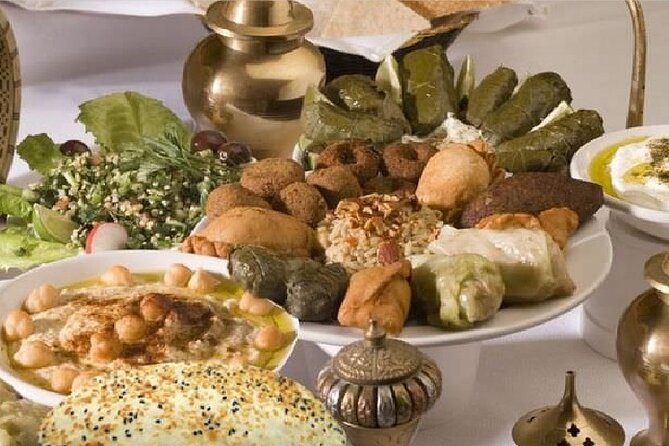In the bustling streets of Istanbul, a hungry traveler stumbles upon a small eatery tucked away amidst the vibrant chaos. Intrigued by the tantalizing aromas wafting from the kitchen, they step inside and are immediately greeted by warm smiles and a menu bursting with culinary wonders.
Little do they know, this chance encounter will lead them on a captivating journey through the rich tapestry of Turkish cuisine, where the flavors, traditions, and history intertwine to create a truly unforgettable dining experience. From the ancient Silk Road to the influences of various civilizations, this article dives deep into the origins and cultural significance of Turkish food, revealing the secrets behind iconic dishes and lesser-known specialties that have made their way into the hearts (and stomachs) of locals.
So, take a seat at the table and prepare to embark on a mouthwatering adventure through the vibrant world of Turkish cuisine.
Good To Know

- Turkish cuisine is a fusion of flavors from the Middle East, Central Asia, and the Mediterranean, influenced by the Ottoman Empire and the Silk Road.
- Traditional Turkish dishes include Doner Kebab, Baklava, Lahmacun, Manti, and Turkish Tea.
- Spices and flavors commonly used in Turkish cuisine include Sumac, Cumin, Paprika, Mint, and Cinnamon.
- Turkish desserts, such as Baklava, Turkish Delight, and Sutlac, have unique flavors and textures influenced by various regions and cultures.
Origins of Turkish Cuisine
Where did Turkish cuisine originate from?
Turkish cuisine has a rich and diverse history that has been shaped by various influences over the centuries. The origins of Turkish cuisine can be traced back to the Ottoman Empire, which spanned from the 14th to the early 20th century. During this time, the empire expanded its territories and absorbed the culinary traditions of the regions it conquered. This resulted in a fusion of flavors and techniques from the Middle East, Central Asia, and the Mediterranean.
Plus, Turkish cuisine has been influenced by the Turkic nomadic traditions, which emphasized the use of meat and dairy products. Today, Turkish food traditions continue to thrive, with dishes like kebabs, baklava, and Turkish tea becoming widely popular worldwide. The influences on Turkish cuisine and the preservation of traditional recipes have made it a unique and beloved culinary tradition.
Enjoying the local flavors? More Istanbul food experiences we've written about
Traditional Turkish Dishes

With the rich and diverse origins of Turkish cuisine in mind, it’s time to explore the mouthwatering world of traditional Turkish dishes. Get ready to tantalize your taste buds with these popular Turkish dishes:
Doner Kebab: A staple of Turkish street food, this delicious dish features succulent slices of marinated meat, typically lamb or chicken, served in a warm flatbread with fresh vegetables and a drizzle of tangy yogurt sauce.
Baklava: A sweet treat that’s loved worldwide, Baklava is a delicate pastry made with layers of flaky filo dough, butter, and a sweet syrup made from honey and nuts. It’s a heavenly dessert that melts in your mouth.
Lahmacun: Known as Turkish pizza, Lahmacun is a thin, crispy flatbread topped with a flavorful mixture of minced meat, tomatoes, onions, and herbs. It’s a quick and satisfying meal that’s perfect for on-the-go.
Manti: These tiny dumplings, filled with a mix of ground meat and spices, are served with a rich tomato sauce and a dollop of yogurt. They’re small in size but big on flavor.
Turkish Tea: No Turkish meal is complete without a cup of strong, black tea. Served in small tulip-shaped glasses, Turkish tea is a refreshing and aromatic beverage that’s enjoyed throughout the day.
These traditional Turkish dishes are just a taste of the culinary delights that await you in Turkey. Whether you’re exploring the bustling streets or sitting down for a meal in a cozy restaurant, be sure to savor every bite and experience the rich flavors of Turkish cuisine.
Influences on Turkish Food
In tracing the influences on Turkish food, one cannot overlook the captivating blend of cultures and histories that have shaped this vibrant culinary tradition. Turkish cuisine has evolved over centuries, drawing inspiration from various civilizations that once thrived in the region. From the Ottoman Empire to the Silk Road, the flavors of Turkish food have been enriched by a multitude of cultures. Today, Turkish food continues to make its mark in both modern and international cuisines. Its unique combination of flavors, spices, and cooking techniques has gained recognition and popularity worldwide. Turkish dishes like kebabs, baklava, and Turkish delight have become staples in many countries, offering a taste of the rich heritage and diverse influences that make Turkish cuisine truly extraordinary.
| Turkish Food in Modern Cuisine | Turkish Food in International Cuisine |
|---|---|
| Incorporating traditional ingredients and cooking techniques into contemporary dishes | Becoming a popular choice in restaurants around the world |
| Experimenting with fusion cuisines to create innovative and exciting flavors | Featuring prominently in international food festivals and events |
| Incorporating healthy and natural ingredients to meet the demands of modern health-conscious consumers | Preserving the authenticity and cultural significance of Turkish cuisine while adapting to global tastes |
Spices and Flavors in Turkish Cuisine

The rich and vibrant spices, combined with a harmonious blend of flavors, are the heart and soul of Turkish cuisine. Here are five spices that play a prominent role in Turkish food history:
Sumac: Known for its tangy and citrusy flavor, sumac is often used as a seasoning in Turkish dishes, adding a burst of brightness to salads, kebabs, and stews.
Cumin: This warm and earthy spice is a staple in Turkish cuisine, enhancing the flavors of meat dishes, soups, and rice pilaf.
Paprika: With its vibrant red color and mild heat, paprika adds depth and a touch of smokiness to dishes like lahmacun (Turkish pizza) and roasted vegetables.
Mint: Used both fresh and dried, mint is a refreshing herb that adds a cool and aromatic note to yogurt sauces, salads, and meat marinades.
Cinnamon: A versatile spice, cinnamon is used in both sweet and savory dishes in Turkish cuisine. It adds warmth and complexity to desserts like baklava and rice pudding, as well as to savory dishes like lamb stew.
These spices, along with others like oregano, coriander, and saffron, create the distinct and enticing flavors that make Turkish cuisine so beloved.
Famous Turkish Desserts
Turkish cuisine tantalizes tastebuds with its array of spices and flavors, and now it’s time to indulge in the sweet side of this culinary journey with some famous Turkish desserts.
With a rich history and a blend of influences from the Middle East, Balkans, and Central Asia, Turkish desserts are known for their unique flavors and textures.
One popular sweet treat is baklava, made with layers of phyllo dough, nuts, and syrup.
Another favorite is Turkish delight, a gelatinous candy flavored with rosewater, lemon, or various fruits and dusted with powdered sugar.
For those craving something creamy, there’s sutlac, a delicious rice pudding flavored with vanilla and topped with a caramelized crust.
Turkish dessert recipes are passed down through generations, ensuring that these delectable treats continue to delight sweet tooths around the world.
More tours and activities we've covered in Istanbul
- Istanbul Foodie Tour by Night: Traditional Meyhane & Street Foods
- Taste of Two Continents: Istanbul Food Tour
- Istanbul Evening Sightseeing and Food Tasting Tour
- Evening Food and Culture Tour – Dinner in Asia Dessert in Europe
- PRIVATE Istanbul Food Tour – 10 Tastings Including Raki & Padi
- Local Food, History and Hidden Places Walking Tour in Istanbul
Regional Variations in Turkish Cuisine
With its diverse regions and culinary traditions, the cuisine of Turkey offers a tantalizing array of flavors and dishes. Turkish cuisine is known for its regional variations, each showcasing unique ingredients and cooking techniques.
Here are five interesting aspects of regional variations in Turkish cuisine:
Black Sea region: Famous for its fish dishes, particularly anchovies and trout.
Aegean region: Known for its olive oil-based dishes, fresh seafood, and mezes.
Central Anatolia region: Specializes in meat dishes like kebabs and stews, often cooked in clay pots.
Southeastern region: Influenced by Middle Eastern flavors, featuring spicy kebabs and richly flavored rice dishes.
Mediterranean region: Offers a fusion of Turkish, Greek, and Middle Eastern cuisines, with a focus on fresh vegetables, herbs, and grilled meats.
Along With these regional variations, Turkish cuisine also embraces fusion dishes that combine traditional Turkish flavors with influences from other cultures. This blend of culinary traditions makes Turkish cuisine truly unique and exciting to explore.
Cultural Significance of Turkish Food
Culturally rich and deeply rooted, Turkish food transcends mere sustenance, becoming a vibrant expression of history, tradition, and community. Influenced by a blend of cultural influences, Turkish cuisine reflects the country’s diverse past, showcasing flavors and techniques from the Ottoman Empire, Central Asia, the Middle East, and the Mediterranean. This fusion of culinary traditions creates a unique and distinct flavor profile that sets Turkish food apart. The cultural significance of Turkish food extends beyond the kitchen, as it plays a central role in social gatherings, celebrations, and everyday life. Meals are often shared with family and friends, promoting a sense of togetherness and community. From the traditional meze platters to the famous kebabs and sweet baklava, Turkish food not only satisfies the taste buds but also tells a story of cultural heritage and traditions.
| Cultural Influences | Culinary Traditions |
|---|---|
| Ottoman Empire | Meze platters |
| Central Asia | Kebabs |
| Middle East | Baklava |
| Mediterranean | Turkish tea |
Common Questions
What Are Some Popular Street Foods in Turkey?
Popular street foods in Turkey include delicious dishes such as doner kebab, simit (sesame seed-covered bread), and lahmacun (Turkish pizza). These mouthwatering treats can be found in bustling markets and food stalls throughout the country.
Are There Any Vegetarian or Vegan Options Available in Turkish Cuisine?
Yes, there are plenty of delicious vegetarian and vegan options available in Turkish cuisine. The cuisine is known for its rich flavors and diverse ingredients, influenced by various cultural traditions.
Can You Recommend Any Popular Turkish Beverages?
Turkish tea and Ayran are two popular beverages in Turkey. Turkish tea is a strong black tea served in small glasses, while Ayran is a refreshing yogurt-based drink. Both are enjoyed by locals and visitors alike.
Are There Any Unique Cooking Techniques Used in Turkish Cuisine?
Turkish cuisine showcases a range of unique cooking techniques that enhance the flavors of their dishes. From slow-cooking meat on a spit to skillful grilling and baking, Turkish cuisine offers a delightful culinary experience.
What Are Some Common Ingredients Used in Turkish Desserts?
Some common ingredients used in Turkish desserts include pistachios, walnuts, honey, and rose water. Turkish dessert recipes often feature traditional Turkish sweets like baklava, Turkish delight, and şekerpare. These treats are beloved for their rich flavors and unique textures.
The Sum Up
To sum it up, Turkish cuisine is a tantalizing blend of flavors, history, and cultural significance. From the ancient Silk Road to the influences of diverse civilizations, Turkish food has evolved into a delectable culinary experience.
Whether it’s the iconic baklava or the lesser-known specialties, Turkish dishes never fail to delight taste buds. The vibrant street food scene and bustling markets add a sensory dimension to the journey.
So, come and learn about the richness of Turkish food, and let it transport you to a world of taste and tradition.
More Food Tours in Istanbul
- Istanbul Food and Culture Tour: Dinner at Local Family
- Istanbul Street Food Tour With A Local Guide
- Istanbul Food Tour Ten Tastings and Local Highlights
- Private Turkish Food Night and Rooftop Experience
- Taste of stanbul Food Tour on Two Continents: in Europe & Asia
- Istanbul Vegetarian Street Food Tour in Vibrant Kadköy
More Food & Drink Tours in Istanbul
- Istanbul Food and Culture Tour: Dinner at Local Family
- Istanbul Street Food Tour With A Local Guide
- Istanbul Food Tour Ten Tastings and Local Highlights
- Private Turkish Food Night and Rooftop Experience
- Taste of stanbul Food Tour on Two Continents: in Europe & Asia
- Istanbul Vegetarian Street Food Tour in Vibrant Kadköy
More Tour Reviews in Istanbul
- 2 Days Cappadocia Highlights Tour from Istanbul by Plane
- Private Guided Istanbul Walking Tour
- Istanbul Airport (SAW) Private Transfer to Istanbul Hotels
- 4 Days Istanbul and Cappadocia Luxury Private Tour
- Bosphorus Boat Tour 3 Hour with Asian Side Stop in Istanbul
- Pearls of Turkey – Tour to Cappadocia Pamukkale Laodicea Ephesus
Looking for something different? Other Istanbul activities we've written about
- 2 Days Cappadocia Highlights Tour from Istanbul by Plane
- Private Guided Istanbul Walking Tour
- Istanbul Airport (SAW) Private Transfer to Istanbul Hotels
- 4 Days Istanbul and Cappadocia Luxury Private Tour
- Bosphorus Boat Tour 3 Hour with Asian Side Stop in Istanbul
- Pearls of Turkey – Tour to Cappadocia Pamukkale Laodicea Ephesus
- 2 Days Mount Nemrut, Gobeklitepe and Karahantepe
- Istanbul Bosphorus Dinner Cruise: Turkish Night Show Experience
- Bosphorus Cruise with Breakfast, Sunset and Stop on Asian Side
- Bosphorus Breakfast Cruise
- Traditional Turkish Breakfast on the Bosphorus
- Istanbul Bosphorus Cruise with Turkish Breakfast
